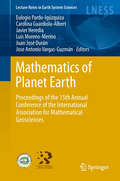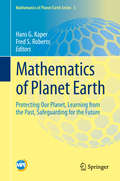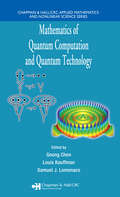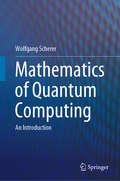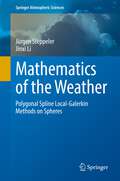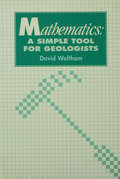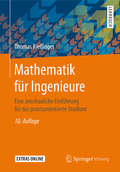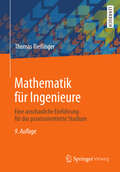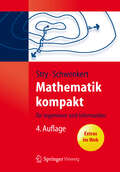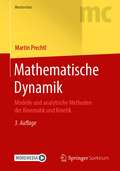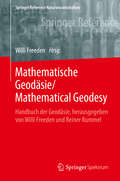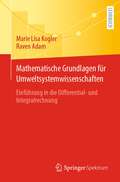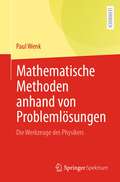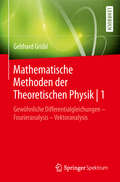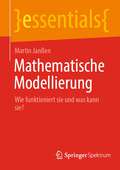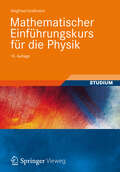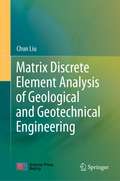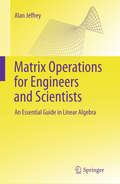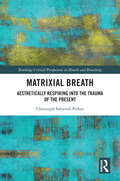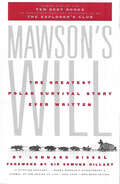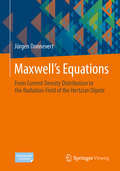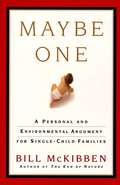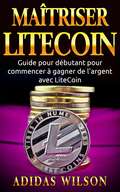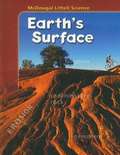- Table View
- List View
Mathematics of Planet Earth
by Juan José Durán Eulogio Pardo-Igúzquiza Carolina Guardiola-Albert Javier Heredia Luis Moreno-Merino Jose Antonio Vargas-GuzmánIt is widely recognized that the degree of development of a science is given by the transition from a mainly descriptive stage to a more quantitative stage. In this transition, qualitative interpretations (conceptual models) are complemented with quantification (numerical models, both, deterministic and stochastic). This has been the main task of mathematical geoscientists during the last forty years - to establish new frontiers and new challenges in the study and understanding of the natural world. Mathematics of Planet Earth comprises the proceedings of the International Association for Mathematical Geosciences Conference (IAMG2013), held in Madrid from September 2-6, 2013. The Conference addresses researchers, professionals and students. The proceedings contain more than 150 original contributions and give a multidisciplinary vision of mathematical geosciences.
Mathematics of Planet Earth: Protecting Our Planet, Learning from the Past, Safeguarding for the Future (Mathematics of Planet Earth #5)
by Hans G. Kaper Fred S. RobertsSince its inception in 2013, Mathematics of Planet Earth (MPE) focuses on mathematical issues arising in the study of our planet. Interested in the impact of human activities on the Earth’s system, this multidisciplinary field considers the planet not only as a physical system, but also as a system supporting life, a system organized by humans, and a system at risk. The articles collected in this volume demonstrate the breadth of techniques and tools from mathematics, statistics, and operations research used in MPE. Topics include climate modeling, the spread of infectious diseases, stability of ecosystems, ecosystem services, biodiversity, infrastructure restoration after an extreme event, urban environments, food security, and food safety. Demonstrating the mathematical sciences in action, this book presents real-world challenges for the mathematical sciences, highlighting applications to issues of current concern to society. Arranged into three topical sections (Geo- and Physical Sciences; Life Sciences, Ecology and Evolution; Socio-economics and Infrastructure), thirteen chapters address questions such as how to measure biodiversity, what mathematics can say about the sixth mass extinction, how to optimize the long-term human use of natural capital, and the impact of data on infrastructure management. The book also treats the subject of infectious diseases with new examples and presents an introduction to the mathematics of food systems and food security. Each chapter functions as an introduction that can be studied independently, offering source material for graduate student seminars and self-study. The range of featured research topics provides mathematical scientists with starting points for the study of our planet and the impact of human activities. At the same time, it offers application scientists a plethora of modern mathematical tools and techniques to address the various topics in practice. Including hundreds of references to the vast literature associated with each topic, this book serves as an inspiration for further research.
Mathematics of Quantum Computation and Quantum Technology
by Goong Chen Louis Kauffman Samuel J. LomonacoResearch and development in the pioneering field of quantum computing involve just about every facet of science and engineering, including the significant areas of mathematics and physics. Based on the firm understanding that mathematics and physics are equal partners in the continuing study of quantum science, Mathematics of Quantum Computation an
Mathematics of Quantum Computing: An Introduction
by Wolfgang SchererThis textbook presents the elementary aspects of quantum computing in a mathematical form. It is intended as core or supplementary reading for physicists, mathematicians, and computer scientists taking a first course on quantum computing. It starts by introducing the basic mathematics required for quantum mechanics, and then goes on to present, in detail, the notions of quantum mechanics, entanglement, quantum gates, and quantum algorithms, of which Shor's factorisation and Grover's search algorithm are discussed extensively. In addition, the algorithms for the Abelian Hidden Subgroup and Discrete Logarithm problems are presented and the latter is used to show how the Bitcoin digital signature may be compromised. It also addresses the problem of error correction as well as giving a detailed exposition of adiabatic quantum computing. The book contains around 140 exercises for the student, covering all of the topics treated, together with an appendix of solutions.
Mathematics of the Weather: Polygonal Spline Local-Galerkin Methods on Spheres (Springer Atmospheric Sciences)
by Jürgen Steppeler Jinxi Li"Mathematics of the Weather” details the mathematical techniques used to create numerical models of the atmosphere. It explains methods which are currently considered for practical use in models for the exaflop computers (10**19 operations per seconds). This book is a guide to developing and modifying the mathematical methods used in such models. This includes Implementations in spherical geometry. The books also concentrates on elements of Numerical Weather Predication (NWP) and Computational Fluid Dynamics (CFD).
Mathematics: A Simple Tool For Geologists
by Waltham, D.Uses geological examples to illustrate mathematical ideas. Contains a large number of worked examples, and problems for students to attempt themselves. Answers to all the questions are given at the end of the book.
Mathematik für Ingenieure
by Thomas Rießinger"Mathematik in entspannter Atmosphäre" ist das Leitbild dieses leicht verständlichen Lehrbuchs. Im Erzählstil und mit vielen Beispielen beleuchtet der Autor nicht nur die Höhere Mathematik, sondern er stellt auch den Lehrstoff in Bezug zu den Anwendungen. Die gesamte für den Ingenieurstudenten wichtige Mathematik wird in einem Band behandelt. Dies gelingt durch Verzicht auf abstrakte Höhen und durch eine prüfungsgerechte Stoffauswahl, die sich streng an den Bedürfnissen des späteren Ingenieurs ausrichtet. Das Buch kann vorlesungsbegleitend oder zum Selbststudium eingesetzt werden. Die 159 Übungsaufgaben mit Lösungen unterstützen das Einüben des Lehrstoffs und sind im Band "Übungsaufgaben zur Mathematik für Ingenieure" ausführlich durchgerechnet.Der "Brückenkurs" beim Buch auf springer.com erleichtert Anfängern den Einstieg.
Mathematik für Ingenieure: Eine anschauliche Einführung für das praxisorientierte Studium
by Thomas Rießinger"Mathematik in entspannter Atmosphäre" ist das Leitbild dieses leicht verständlichen Lehrbuchs. Im Erzählstil und mit vielen Beispielen beleuchtet der Autor nicht nur die Höhere Mathematik, sondern er stellt auch den Lehrstoff in Bezug zu den Anwendungen. Die gesamte für den Ingenieurstudenten wichtige Mathematik wird in einem Band behandelt. Dies gelingt durch Verzicht auf abstrakte Höhen und durch eine prüfungsgerechte Stoffauswahl, die sich streng an den Bedürfnissen des späteren Ingenieurs ausrichtet. Das Buch kann vorlesungsbegleitend oder zum Selbststudium eingesetzt werden. Die 159 Übungsaufgaben mit Lösungen unterstützen das Einüben des Lehrstoffs und sind im Band "Übungsaufgaben zur Mathematik für Ingenieure" ausführlich durchgerechnet. Der "Brückenkurs" auf http://extras.springer.com/2013/978-3-642-36858-5 erleichtert Anfängern den Einstieg.
Mathematik kompakt
by Rainer Schwenkert Yvonne StryDas kompakte einbändige Werk bietet eine aktuelle Stoffauswahl mit Themen wie Wahrscheinlichkeitsrechnung und Statistik, dafür wird auf überflüssige Beweise verzichtet. Die Autoren präsentieren den gesamten Stoff in einem anschaulichen, aufgelockerten Stil - mit Zusammenfassungen und Verständnistests zu jedem Kapitel, Randnotizen für die schnelle Orientierung, Beispielen und Anwendungen sowie zahlreichen Übungsaufgaben mit Lösungen. Ergänzendes Material wie Folien und kommentierte Lösungen stehen im Internet zum Download bereit.
Mathematische Dynamik: Modelle und analytische Methoden der Kinematik und Kinetik (Masterclass)
by Martin PrechtlIn diesem Lehrbuch werden folgende Themengebiete abgedeckt: Kinematik, Massenpunkt- und Starrkörperkinetik, Mehrkörpersysteme und schwingungsfähige Systeme – einschließlich ausgewählter Fragestellungen der sogenannten Maschinendynamik. Dabei liegt der Fokus auf den analytischen Lösungsmethoden. Zudem wird die praktische Relevanz der Dynamik mit einem wissenschaftlich-theoretischen Fundament verknüpft. Alle hierfür nötigen Herleitungen sind im Text integriert und in ausführlicher Form erklärt. Um den Komplex der Dynamik zu erfassen, werden einfache Beispiele mit verschiedenen Ansätzen gerechnet und auf Vor-/Nachteile verglichen. Jene Aufgaben sind derart strukturiert, dass man die Vorgehensweise bei der Lösungsfindung anhand eingängiger Konstellationen leicht nachvollziehen kann – wie beispielsweise bei der Wahl eines zweckmäßigen Koordinatensystems. Folglich ist das Buch Grundlagenlektüre und Nachschlagewerk zugleich, für alle, die sich die Theorie technischer Bewegungsvorgänge erarbeiten wollen. Ein eigenes Übungskapitel mit „gemischten Arbeitspaketen“ rundet das Lehrbuch ab; für alle Aufgaben ist eine Lösungsvariante skizziert und ausführlich kommentiert. Zur Vertiefung der Eigenschaften ausgewählter mechanischer Systeme werden virtuelle Modelle mit dem kostenlosen Tool SimulationX angeboten: Videos geben dabei einen hilfreichen Überblick und Simulationen können von den LeserInnen selbst ausgeführt, modifiziert und weiterentwickelt werden. Diese interaktiven Beispiele bieten damit auch einen spielerischen Zugang zur Welt der Technischen Dynamik, außerdem absolviert man nebenbei einen kleinen Crash-Kurs in SimulationX.
Mathematische Geodäsie/Mathematical Geodesy: Handbuch der Geodäsie, herausgegeben von Willi Freeden und Reiner Rummel (Springer Reference Naturwissenschaften)
by Willi FreedenSelbstkonsistente Darstellung von Schlüssel- und Transfermethodologien vom Realitätsraum geodätischer Messungen und Beobachtungen in den Modellraum mathematischer Strukturen und Lösungen und zurück, neue Perspektiven und Forschungstrends im Bereich Mathematischer Geodäsie.
Mathematische Grundlagen für Umweltsystemwissenschaften: Einführung in die Differential- und Integralrechnung
by Marie Lisa Kogler Raven AdamProzesse in Umweltsystemen werden durch Größen beschrieben, die miteinander gekoppelt sind und so das Systemverhalten prägen. Diese Zusammenhänge können mittels Funktionen mathematisch beschrieben und verstanden werden.Das vorliegende Lehrbuch widmet sich anschaulich der Differential- und Integralrechnung und ist insbesondere für das Studium der Umweltsystemwissenschaften und vergleichbare anwendungsorientierte Studiengänge geeignet. Zahlreiche Skizzen, Bilder und detailreiche Erläuterungen dienen der Visualisierung und Veranschaulichung. Eine große Menge an Beispielen mit ausführlich dargestellten Lösungswegen fördert sowohl methodische Kenntnisse als auch ein Verständnis für Anwendbarkeit. Verschiedene Anwendungsbeispiele zu ausgewählten Themen dienen dazu, die theoretischen Kenntnisse in der Praxis anwenden zu können. Die Themengebiete umfassen Funktionen, Folgen und Reihen, Grenzwerte, Stetigkeit, Grundlagen der Differential- und Integralrechnung, mehrdimensionale Funktionen und deren Ableitungen, Taylor-Entwicklung und Koordinatensysteme. Jedes Kapitel beinhaltet Beispielkataloge zum Selbststudium. Die umweltsystemwissenschaftlichen Beispiele reichen von Räuber-Beute-Systemen, wirtschaftlich nachhaltiger Produktion und dem Wärmeinseleffekt bis hin zu biologischen Auswirkungen von Giftstoffen.
Mathematische Methoden anhand von Problemlösungen: Die Werkzeuge des Physikers
by Paul WenkDie mathematischen Sätze gelernt? Die Formeln auch? Nun fehlt noch das Wichtigste: die Anwendung des Gelernten auf Probleme, die über ein einfaches Beispiel hinausgehen. Die mathematischen Werkzeuge, die man sich in jedem naturwissenschaftlichen Studium aneignet, lernt man schließlich erst bei der Bearbeitung von Problemen wirklich kennen. Jedoch kann das Lernen oft frustrierend werden, wenn man die Lösung nicht findet, die Lektüre diese als trivial abtut oder nur schlicht durch eine nackte Zahl ohne erläuternden Kommentar angibt.Das vorliegende Lehrbuch macht die Lesenden mit zentralen mathematischen Werkzeugen für den Physiker vertraut. Dabei werden wichtige Standardaufgaben sowie physikalische Problemstellungen ausführlich gelöst und parallel dazu die Lösungswege diskutiert. Der Schwerpunkt liegt insbesondere auf der Verknüpfung der verschiedenen Aufgaben, und zwar unabhängig vom Schwierigkeitsgrad, so dass das Lösen immer komplexerer Aufgaben schrittweise erleichtert wird. Infolgedessen sind die Lösungen keine bloße Ergänzung, sondern ein zentraler Bestandteil dieses Lehrbuchs.
Mathematische Methoden der Theoretischen Physik | 1: Gewöhnliche Differentialgleichungen – Fourieranalysis - Vektoranalysis
by Gebhard GrüblDas vorliegende Buch behandelt die wichtigsten mathematischen Themen der Vorlesungen über Theoretische Physik. Es ergänzt damit die mathematischen Grundlagen, die Studierende der Physik im Rahmen der Vorlesungen über Analysis und Lineare Algebra vermittelt bekommen. Der Autor verzichtet dabei zwar vielfach auf ausführliche Beweise, nicht aber auf eine präzise Formulierung der Sachverhalte. Zahlreiche physikalische Beispiele sollen ein gründliches Verständnis der mathematischen Zusammenhänge befördern und deren Bedeutung für unser Naturverständnis erschließen. Eine Sammlung von Aufgaben am Ende des jeweiligen Kapitels bietet den Leserinnen und Lesern Gelegenheit zur Übung. Der Inhalt dieses Teils deckt die gewöhnlichen Differentialgleichungen, Fourieranalysis und koordinatenfreie Differentialrechnung in Vektorräumen ab und begleitet mathematisch so die Theorievorlesungen zur Mechanik und Elektrodynamik. Das Buch bietet dabei nicht nur die notwendigen Grundlagen, sondern auch vertiefende Themen, die über den regulären Kanon hinausgehen oder eine konkrete Anwendung des Behandelten aufzeigen. Für eine effiziente Verwendung sind diese Kapitel klar mit einem Stern gekennzeichnet und können damit beim ersten Lesen übersprungen werden. Somit kann dieses Werk begleitend zu den Vorlesungen eingesetzt werden, aber auch darüber hinaus zur eigenständigen Verfestigung quer über verschiedene Themenbereiche hinweg anleiten.
Mathematische Modellierung: Wie funktioniert sie und was kann sie? (essentials)
by Martin JanßenMathematische Modellierung (MM) dient als Planungswerkzeug für Entscheidungen, von denen wir alle zunehmend betroffen sind. Über das Vorgehen und die Aussagekraft von MM ist daher ein grundlegendes Verständnis auch ohne akademische Vorbildung wünschenswert. MM benötigt zwei wesentliche Elemente: Das Auffinden relevanter Einflussgrößen und das Auffinden einer kleinschrittigen Regel, die den Ablauf von Szenarien schrittweise erfasst. Im Text werden prototypische Modelle vorgestellt, die weite Anwendungsbereiche haben. Die Grenzen vom MM ergeben sich aus unvermeidbaren Beschränkungen in der Genauigkeit und sie führen zu einer Verzweigung von Modellen in vernetzte Modellsysteme.
Mathematischer Einführungskurs für die Physik
by Siegfried GroßmannStudierende, die ein Physikstudium aufnehmen, brauchen zu Beginn vor allem eines: mathematische Grundkenntnisse. Da es sich hierbei zunächst um einen relativ beschränkten und charakteristischen Ausschnitt aus der Mathematik handelt, werden die benötigten Kompetenzen vor allem im Rahmen von Tutorien oder Arbeitsgruppen vermittelt. Dieser Einführungskurs soll Studierenden im ersten Semester helfen, die Inhalte dieser Veranstaltungen zu vertiefen und möglichst rechtzeitig die Fähigkeiten zu erwerben, die ein erfolgreiches Physikstudium garantieren.
Matrix Discrete Element Analysis of Geological and Geotechnical Engineering
by Chun LiuThis book introduces the basic structure, modeling methods, numerical calculation processes, post-processing, and system functions of MatDEM, which applies the basic principles and algorithm of the discrete element method. The discrete element method can effectively simulate the discontinuity, inhomogeneity, and large deformation damage of rock and soil. It is widely used in both research and industry. Based on the innovative matrix discrete element computing method, the author developed the high-performance discrete element software MatDEM from scratch, which can handle millions of elements in discrete element numerical simulations. This book also presents several examples of applications in geological and geotechnical engineering, including basic geotechnical engineering problems, discrete element tests, three dimensional landslides, and dynamic and multi-field coupling functions. Teaching videos and the relevant software can be accessed on the MATDEM website (http://matdem.com). The book serves as a useful reference for research and engineering staff, undergraduates, and postgraduates who work in the fields of geology, geotechnical, water conservancy, civil engineering, mining, and physics.
Matrix Operations for Engineers and Scientists
by Alan JeffreyEngineers and scientists need to have an introduction to the basics of linear algebra in a context they understand. Computer algebra systems make the manipulation of matrices and the determination of their properties a simple matter, and in practical applications such software is often essential. However, using this tool when learning about matrices, without first gaining a proper understanding of the underlying theory, limits the ability to use matrices and to apply them to new problems. This book explains matrices in the detail required by engineering or science students, and it discusses linear systems of ordinary differential equations. These students require a straightforward introduction to linear algebra illustrated by applications to which they can relate. It caters of the needs of undergraduate engineers in all disciplines, and provides considerable detail where it is likely to be helpful. According to the author the best way to understand the theory of matrices is by working simple exercises designed to emphasize the theory, that at the same time avoid distractions caused by unnecessary numerical calculations. Hence, examples and exercises in this book have been constructed in such a way that wherever calculations are necessary they are straightforward. For example, when a characteristic equation occurs, its roots (the eigenvalues of a matrix) can be found by inspection. The author of this book is Alan Jeffrey, Emeritus Professor of mathematics at the University of Newcastle upon Tyne. He has given courses on engineering mathematics at UK and US Universities.
Matrixial Breath: Aesthetically Respiring into the Trauma of the Present (Routledge Critical Perspectives on Breath and Breathing)
by Christoph Solstreif-PirkerDay by day, the global climate crisis intensifies, yet there are little changes in the behavior of privileged societies. This book reveals that such paradoxical behavior is due to the prevalence of a narrative that considers planet Earth as a self-sustaining system, driven by a circular respiration pattern from one actor to the next. It argues that transforming this prevailing planetary breathing pattern is necessary to change humans’ destructive behavior towards the morethan- human environment. The volume, in particular, references the feminine Matrixial Theory of psychoanalyst and philosopher Bracha L. Ettinger. In linking the Matrixial Theory to environmental issues for the first time, it explores the rhythms and scopes of a Matrixial breath and what alternative forms of relationship between humans and nature might emerge from it. It lays the foundation for an urgently needed subversion of thought and action toward novel ethics of breathing-with beyond homeostatic reductionism.The first of its kind, this volume will be indispensable for students and researchers of environmental ethics, feminist thought, climate studies, social change, or critical theory. It will also be useful to cultural scientists, artists, philosophers, ecologists, theologians, architects, therapists, social workers, educators, and politicians.
Mawson's Will: The Greatest Survival Story Ever Written
by Sir Edmund Hillary Lennard BickelMAWSON'S WILL is the dramatic story of what Sir Edmund Hillary calls "the most outstanding solo journey ever recorded in Antarctic history." For weeks in Antarctica, Douglas Mawson faced some of the most daunting conditions ever known to man: blistering wind, snow, and cold; loss of his companion, his dogs and supplies, the skin on his hands and the soles of his feet; thirst, starvation, disease, snowblindness - and he survived. Sir Douglas Mawson is remembered as the young Australian who would not go to the South Pole with Robert Scott in 1911, choosing instead to lead his own expedition on the less glamorous mission of charting nearly 1,500 miles of Antarctic coastline and claiming its resources for the British Crown. His party of three set out through the mountains across glaciers in 60-mile-per-hour winds. Six weeks and 320 miles out, one man fell into a crevasse, along with the tent, most of the equipment, all of the dogs' food, and all except a week's supply of the men's provisions.Mawson's Will is the unforgettable story of one man's ingenious practicality and unbreakable spirit and how he continued his meticulous scientific observations even in the face of death. When the expedition was over, Mawson had added more territory to the Antarctic map than anyone else of his time. Thanks to Bickel's moving account, Mawson can be remembered for the vision and dedication that make him one of the world's great explorers."A riveting account . . . makes Mawson's achievement a symbol of the desire to live." -- The New York Times Book Review"A powerful reading experience." -- Publishers WeeklyFrom the Trade Paperback edition.
Maxwell´s Equations: From Current Density Distribution to the Radiation Field of the Hertzian Dipole
by Jürgen DonnevertThis book focuses on the derivation and solution of Maxwell’s equations. The stations along the way include the laws of potential and current density distribution, as well as the laws of electrostatics and stationary magnetic fields. The book is chiefly intended for students of electrical engineering, information technology, and physics; the goal is to prepare them for courses on Electromagnetic Field Theory (EFT). Building on what they have learned in advanced physics and mathematics courses at secondary school or technical college, it is intended to accompany university-level EFT courses. Particular importance is attached to detailed explanations in text form, combined with a wealth of illustrations. All formulas are derived step by step.
Maybe One
by Bill MckibbenFrom the groundbreaking, bestselling author of The End of Nature, a controversial and provocative book arguing that to help the planet we should begin to voluntarily limit our numbers. Bill McKibben's books and essays on our environment -- physical and spiritual -- have shaped and spurred debate since The End of Nature was published in 1989. Then, he sounded one of the earliest alarms about global warming; the decade of science since has proved his prescience. Now, in Maybe One, he takes on the most controversial of environmental problems -- population. We live in a unique and dangerous time, he asserts, when the planet's limits are being tested and voluntary reductions in American childbearing could make a crucial difference. The father of a single child himself, McKibben maintains that bringing one, and no more than one, child into this world will hurt neither your family nor our nation -- indeed, it can be an optimistic step toward the future. Maybe One is not just an environmental argument but a highly personal and philosophical one. McKibben cites new and extensive research about the developmental strengths of only children; he finds that single kids are not spoiled, weird, selfish, or asocial, but pretty much the same as everyone else. McKibben recognizes that the transition to a stable population size won't be easy or pain-free but ultimately is inevitable. Maybe One provides the basis for provocative, powerful thought and discussion that will influence our thinking for decades to come.
Maîtriser LiteCoin: Guide pour débutant pour commencer à gagner de l'argent avec LiteCoin
by Essaid Bahri Adidas WilsonLitecoin a été fondé pour agir comme alternative au Bitcoin afin de remédier aux lacunes constatées dans le réseau Bitcoin— il a été conçu pour être « léger » et plus prolifique que Bitcoin.Litecoin a également un coût de paiement quasi nul et facilite les paiements presque quatre fois plus vite que Bitcoin.
McDougal Littell Science: Earth’s Surface
by Mcdougal LittellScientists are curious. Since ancient times, they have been asking and answering questions about the world around them. Scientists are also very suspicious of the answers they get.
